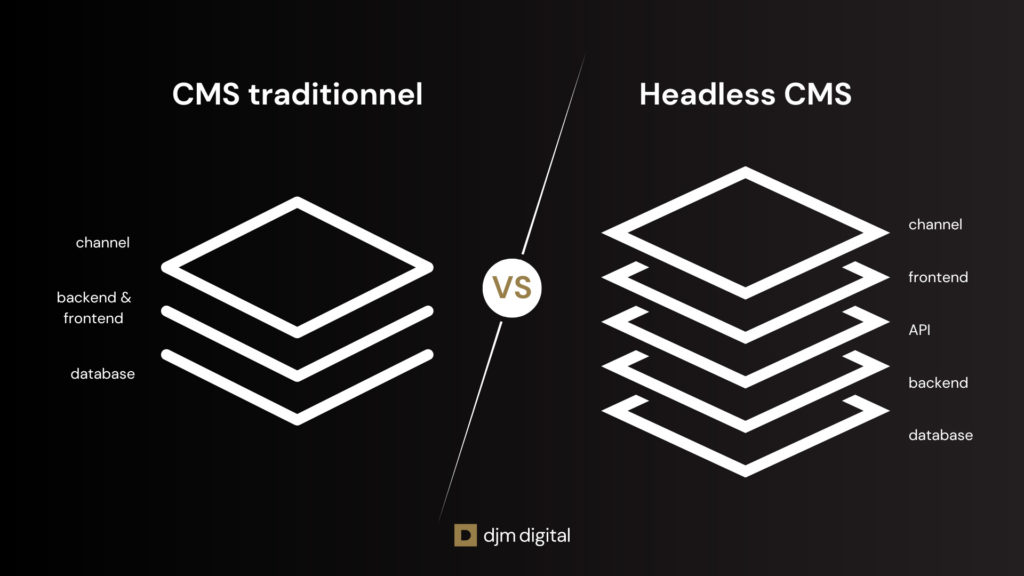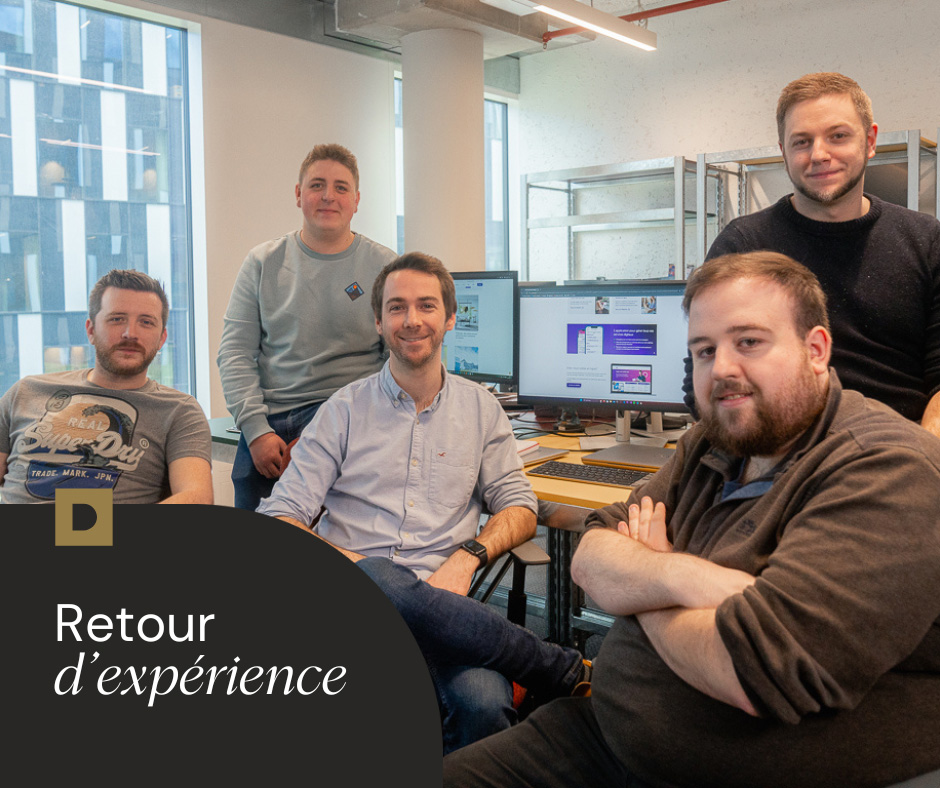
Écrit par Sébastien Rigaux,
CTO at djm digital
Choosing the right content management system (CMS) is a strategic decision for your business. Whether you’re considering a traditional CMS like WordPress, Drupal or Adobe Experience Manager (AEM), or a headless CMS like Contentful, Strapi, Directus, Prismic or Payload, understanding the key differences can guide your choice. In this article, I’d like to give you some feedback on the specifics of each type of CMS and the situations in which I prefer one or the other.
What’s the difference between the two?
Traditional CMS integrate content management and presentation on a single platform. You manage and display the content via a single interface. By contrast, a headless CMS separates content management from content presentation. The content is stored in a database and distributed via APIs to various channels: websites, mobile applications, connected objects, etc.
Technical stack and resources required
A traditional CMS may seem more accessible and simpler to develop at first glance, with centralised management making it easier to set up. However, the admin interface can quickly become complex as more functionality is added, since everything is managed from the same platform. This can require technical skills to optimise and maintain performance over the long term.
Conversely, a headless CMS, although requiring skilled developers to integrate the CMS and its front-end, allows you to create a very user-friendly, intuitive and high-performance back-office. This approach makes it possible to use the best front-end technologies and to customise the user interface according to the specific needs of your project.
If you entrust the development of your site to DJM, we ensure that your team is autonomous, thanks to a back-office that is user-friendly and easy to manage, even if the underlying technology is more complex. Our aim is to provide you with the most flexible and scalable solution, tailored to your current and future needs.
Flexibility
When it comes to flexibility, headless CMSs win hands down! Traditional CMS are perfectly suited to classic sites with no need for custom functionality. However, they can quickly show their limitations when it comes to implementing very specific functionalities.
Headless CMS, on the other hand, are highly flexible, thanks to their multi-technology adaptability. By separating the management of content from its presentation, they allow the use of any front-end technology, such as React, Angular or Vue.js, opening the door to much greater levels of customisation and integration. For example, for a product-oriented strategy, a product information management system (PIM) can be integrated.
Development speed
If you’re looking for rapid development, traditional CMS are usually the first choice. Thanks to their user-friendly interfaces and numerous plugins and ready-to-use themes, sites can be set up quickly. You can easily manage and update content without the need for additional development.
By contrast, headless CMSs, which require separate front-end and back-end development, can take longer to set up. The extensive customisation and specific integrations required can lengthen the initial development time. However, once your site is delivered, you benefit from a more flexible and scalable architecture.
Development speed
Traditional CMS offer numerous plugins to optimise performance. However, their monolithic architecture can lead to slowdowns, especially under heavy load, and require increased maintenance to remain optimal. For example, a WordPress e-commerce site may require additional optimisation to maintain performance during peak periods.
Headless CMS, with their decentralised architecture, enable more efficient management of resources. Because we develop the back-end and front-end separately, we can optimise each component individually to ensure optimum performance, particularly during peak traffic periods. This approach is particularly beneficial for e-commerce platforms, where speed and reliability are crucial to managing high volumes of transactions in real time and delivering a smooth, uninterrupted user experience.
Multi-channel SEO and content management
Depending on your SEO strategy, your sector and the competition you face, we will advise you whether to opt for a traditional or headless CMS.
If your online presence is mainly centred on a single website and your technical resources are limited, a traditional CMS could be the ideal solution. These CMSs offer numerous plugins to optimise SEO and centralise content management on a single interface.
However, for more advanced SEO strategies and a multi-channel presence, headless CMSs offer greater flexibility. They enable the same content to be managed and distributed simultaneously across a website, a mobile application and social networks, each with its own SEO requirements. This centralisation and personalisation of content for each channel enhances the effectiveness of SEO strategies and reduces the risk of duplicate content.
Costs and management
Traditional CMS are often cheaper and easier to manage in the short term. With integrated hosting solutions and an active community providing numerous plugins, they allow you to get started quickly with low initial costs. In the long term, however, costs can rise due to potential upgrades and limitations that may require bespoke solutions. Not to mention the fact that the large number of plugins (which are not always compatible with each other) can slow down the website and may not fully meet requirements.
Headless CMS, although potentially more expensive at the outset due to the need to develop custom front-end solutions, can offer long-term savings thanks to their flexibility and ability to adapt to new technologies and requirements without requiring a complete overhaul.

My advice for choosing the right CMS
The choice of CMS, whether traditional or headless, does not depend solely on the size of the company. Headless is not just for large companies with complex infrastructures; it can also be highly relevant for innovative start-ups or projects requiring extensive customisation.
We have also developed several headless projects for start-ups as part of the DJM Lab, our centre dedicated to start-ups. This flexibility means that any company, from very small businesses to multinationals, can benefit from a modern, scalable architecture.
When should you choose a traditional CMS?
- Monolithic projects: For simple websites with no need for advanced functionality or multi-channel distribution.
- Cost optimisation: Traditional CMS can be more economical in the short term, with hosting solutions often included or inexpensive.
- Speed of implementation: Traditional CMS can speed up site implementation thanks to the themes and plugins available.
When should you opt for a headless CMS?
- Large-scale projects requiring scalability and customisation: With skilled technical teams and specific requirements, a headless CMS offers optimum flexibility and performance.
- Multi-channel projects: For projects requiring content to be distributed across several channels (websites, mobile applications, connected objects).
- Need for increased performance: For sites requiring optimum performance and great flexibility in terms of technology.
- Advanced customisation: When the project requires extensive front-end customisation and the use of modern technologies.
DJM, your partner for the right technology choice
From consultancy to implementation, DJM is there to support you! Whether your project is a simple website redesign or a complex solution requiring, for example, a MACH architecture (Microservices, API-first, Cloud-native, and Headless), our agency is your partner for developing a website that perfectly matches your needs.
In conclusion, the choice between a traditional CMS and a headless CMS depends on your specific needs, your resources and your long-term objectives. Each solution has its advantages and disadvantages, and it’s crucial to assess your needs carefully before making a decision.
Need help determining the scope of your project? Contact DJM for expert advice and tailor-made support!

CTO in djm digital



